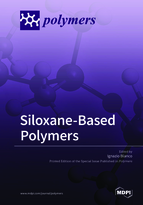Siloxane-Based Polymers
A special issue of Polymers (ISSN 2073-4360).
Deadline for manuscript submissions: closed (15 March 2018) | Viewed by 87575
Special Issue Editor
Interests: materials; polymers; thermal properties; nanocomposites; composites
Special Issues, Collections and Topics in MDPI journals
Special Issue Information
Dear Colleagues,
Since the birth of chemistry, inorganic and organic compounds have been considered two separate worlds owing to their completely different properties and structure. Due to the progress of the science in this field, it is possible today to obtain hybrid inorganic–organic materials, thus having the properties of both of them, different than those achievable by a simple blend at macroscopic level. In this frame, the synthesis of Siloxane-Based Polymers represents at the same time a challenge and a fascinating field of research, and offers the opportunity of obtaining compounds with new unique properties. We invite authors to submit original research and review articles that report the synthesis and characterization of these hybrid materials and that attest an enhancement of their chemical, physical and mechanical properties in respect to the polymer matrix. We are interested in traditional and new chemical processes will contribute to the preparation of such materials and in new processing technologies articles. The aim is also to cover the exploration of the interaction between inorganic filler and organic matrix.
We cordially invite experts in the field of siloxane-based polymers to submit papers to this Special Issue.
Prof. Dr. Ignazio Blanco
Guest Editor
Manuscript Submission Information
Manuscripts should be submitted online at www.mdpi.com by registering and logging in to this website. Once you are registered, click here to go to the submission form. Manuscripts can be submitted until the deadline. All submissions that pass pre-check are peer-reviewed. Accepted papers will be published continuously in the journal (as soon as accepted) and will be listed together on the special issue website. Research articles, review articles as well as short communications are invited. For planned papers, a title and short abstract (about 100 words) can be sent to the Editorial Office for announcement on this website.
Submitted manuscripts should not have been published previously, nor be under consideration for publication elsewhere (except conference proceedings papers). All manuscripts are thoroughly refereed through a single-blind peer-review process. A guide for authors and other relevant information for submission of manuscripts is available on the Instructions for Authors page. Polymers is an international peer-reviewed open access semimonthly journal published by MDPI.
Please visit the Instructions for Authors page before submitting a manuscript. The Article Processing Charge (APC) for publication in this open access journal is 2700 CHF (Swiss Francs). Submitted papers should be well formatted and use good English. Authors may use MDPI's English editing service prior to publication or during author revisions.
Keywords
- Siloxane
- Copolymer
- Hybrid materials
- POSS
- Coatings
- Membrane
- Nanomedicine
- Thermal properties
- Mechanical properties
- Pendent groups
- Optical properties
Related Special Issue
- Silicon-Containing Polymeric Materials in Polymers (130 articles)







